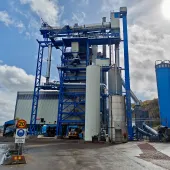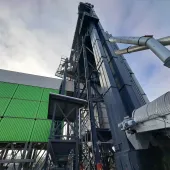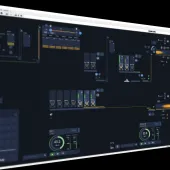New Coating Plant for South Ayrshire

First published in the January 2016 issue of Quarry Management
Hillhouse Quarries choose state-of-the-art Benninghoven asphalt plant for Troon
Hillhouse Quarry Group are one of Scotland’s largest privately owned heavy building materials businesses, supplying drystone, coated stone and concrete products to markets throughout Central and Southern Scotland, particularly Ayrshire and the Glasgow area. The company was founded more than a century ago with the opening of Hillhouse Quarry, near Troon, in 1907 and has remained in the ownership of the Vernon family since that date. Today the business employs around 150 people and comprises two hard rock quarries, a sand and gravel quarry, four bituminous coating plants, a surfacing division, four ready-mixed concrete plants and a precast concrete and block business.
Ongoing expansion of the group and investment in new plant and equipment has seen production capacity increase in all product streams over the last five years. The Hillhouse Quarry site has the capacity to deliver more than 1 million tonnes of drystone per annum. In addition to this, the Troon quarry’s coating plants have had to be upgraded over the years to meet increasing demand for bituminous mixes.
The latest phase of major investment, to maintain the group as an industry leader with modern, efficient plant, is the addition of a new state-of-the-art asphalt plant from Benninghoven as part of a £3 million asphalt production facility to increase operating efficiency and realign output with changing market requirements.
Commenting on the new plant and its selection, operations director Justin Gill said: ‘The new plant combined with our other assets gives us the output and flexibility required to service major construction and trunk road contracts across the central belt of Scotland. Already the new plant is supporting the supply of some 650,000 tonnes of coated materials from the Hillhouse Group to the £500 million Scottish Government contract for the M8/M73/M74. The new plant complements our existing Benninghoven plant, and the relationship that we have built with Benninghoven over the years was key in our decision for the new plant. With three coating plants on site at Troon, we are able to give the best service and a supply capacity second to none.’
Designed to provide significant operational benefits and cost savings, the new Benninghoven model BA4000U plant is able to produce a wide range of high-specification coated materials, including modern thin surfacings, stone-mastic asphalts and other specialized mixes. The plant has a rated production capacity of 320 tonnes/h at 4% initial moisture (DBM).
The tower design minimizes energy consumption through all stages of the asphalt production process, combining innovative design with optimum insulation and power management, to minimize running costs without affecting performance and product quality.
The aggregate cold feed consists of an in-line set of eight hoppers with belt feeders that discharge on to a 37m collecting conveyor, which, in turn, feeds on to a 13m feed conveyor. Both conveyors are fully covered and mounted on trestles with safety pull-wires along their walkways. A further feed conveyor delivers material directly into the dryer.
The aggregate dryer drum, which is 2.8m in diameter x 10m in length, is fully lagged with 70mm thick insulation and aluminium clad for heat retention and noise reduction. The drum is friction driven by four support rollers through individual 22kW inverter-controlled geared motor units.
The burner, a Benninghoven Evo Jet FU gas oil model, is designed to minimize CO2 emissions. This compact unit is equipped with a full range of operating and safety devices to deliver high-efficiency fuel usage. An air inlet silencer is connected to the burner to suppress noise levels, and the burner and silencer are mounted on a track to allow the unit to slide back from the dryer for routine servicing.
The plant’s modular-design dust-collection system, which is rated at 84,000Nm3/h, is sized for the dryer and mixing section scavenging, and achieves emission levels of less than 25mg/m3. A primary drop-out box mounted alongside the dryer separates any coarse dust from the airstream, which passes to the hot-stone elevator feed boot via a gravity flap valve and chute. The secondary cassette-type filter system, which features filter elements arranged vertically, collects any remaining dust and transfers it, via two screw conveyors, to the filler elevator. A dust monitor mounted on the exhaust stack provides a remote readout in the operator’s cabin. As a result, the plant meets the most stringent dust-control regulations.
Hot aggregates are transported from the dryer up to the screen by a 37m vertical bucket-type elevator. This is totally enclosed and features a heavy-duty double-strand chain and wear-resistant steel buckets with replaceable liner plates at impact points. Elevator drive is by a 55kW geared motor and toothed chain wheels at the elevator head. The elevator features outside-located bearings and a safety backstop facility. A wide platform provides access for maintenance.
Material discharged from the elevator passes into a six-deck screen which features twin drive via two 19kW ‘bolt on’ low-maintenance vibrating motors. These drive units are mounted outside the screen housing to allow for high-temperature screening of materials. Wide access doors, together with a roll-away chute, provide access to all screen decks. An extraction fan ensures negative pressure is maintained in the screen housing for optimum dust control.
The hot storage section has an enlarged capacity of 210 tonnes and comprises seven bins. All the bins are insulated and clad, and each is fitted with a continuous level indicator and overflow chute. Discharge from each bin is via a pneumatically operated radial door which accurately regulates material flow to the aggregate weigh hopper, from where the aggregates are discharged directly into the mixer.
Accurate weighing out of ingredients is achieved by separate load-cell-mounted weigh hoppers, comprising a 4,000kg capacity aggregate weigh hopper, a 600kg capacity filler weigh hopper, and a 450-litre capacity weigh vessel for bitumen. Mixing takes place in an insulated 4,000kg capacity, twin-shaft paddle mixer, with drive provided by two 55kW geared motor units, through synchronized gears. A radiation pyrometer is situated at the mixer discharge to indicate mix temperature.
Mixed material discharged from the mixer falls into a 4,000kg skip unit which runs on horizontal tracks and distributes the material into 100-tonne capacity silos, arranged into two 50-tonne compartments. All are equipped with high-level warning indicators and are insulated and fitted with electric trace heating around discharge doors. A 10-tonne direct load-out hopper is positioned beneath the mixer, and all bins are mounted on load-cells to ensure accurate material loading.
Bitumen is stored in three 100m3 capacity vertical tanks sited adjacent to the plant, all of which are Benninghoven’s latest electric high thermal efficiency units, which give low running costs owing to their stepped heating system design. An in-built loading system with high-level probes offers fail-safe filling with no possibility of spillage and complies with the latest Eurobitume/RBA standards.
Filler is stored in a silo tower that is split into two separate compartments holding approximately 90m3 of reclaimed filler and 60m3 of imported filler. Both compartments are equipped with level indicators and shut-off valves.
A gravimetric additive system is also incorporated in the plant to feed granulated material from a 30m3 silo. Each batch of granulate is accurately weighed in a load-cell-mounted weigh hopper before being discharged through a butterfly valve to the mixer.
A cold RAP system has been incorporated in the facility to deliver precise percentages directly into the plant mixer. The system comprises a steep-sided 15m3 capacity feed hopper, fitted with an oversize grid and two vibrators. A belt feeder mounted beneath the hopper discharges the RAP on to a 15m long inclined conveyor, which feeds directly on to a transfer conveyor and a recycling elevator leading up to mixer level, where a weigh conveyor holding hopper and flap-type inlet chute arrangement discharges the material into the mixer. The system is designed to ensure accurate proportioned batches, while an automatic vent duct connected to the mixer allows rapid extraction of steam during recycling operations.
The plant is controlled by a Benninghoven BLS3000 computer system that displays all plant functions using colour graphics. The system, which is housed in an existing control cabin adjacent to the plant, is modem linked and provides storage for up to 500 asphalt mix recipes.
Acknowledgement
Thanks are due to Hillhouse Quarry Group Ltd’s operations director, Justin Gill, and quarry manager, Garry Jones; and to Nigel Moreton of Wirtgen Ltd, for their help in preparing this report.
- Subscribe to Quarry Management, the monthly journal for the mineral products industry, to read articles before they appear on Agg-Net.com








